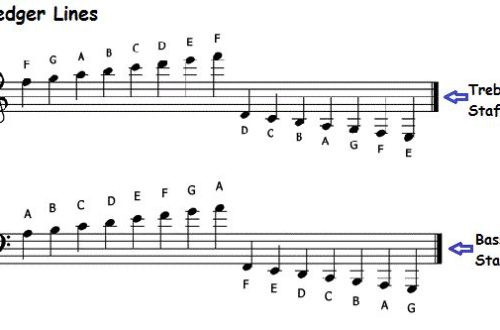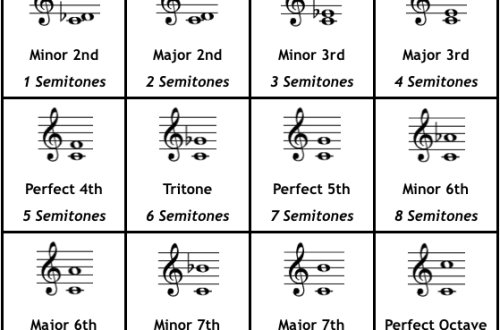
Parallel keys: what is it and how to find them?
Contents
The last issue was devoted to the consideration of such musical concepts as mode and tonality. Today we will continue to study this big topic and talk about what parallel keys are, but first we will very briefly repeat the previous material.
Fundamentals of mode and tonality in music
Lad – this is a specially selected group (gamma) of sounds, in which there are basic – stable steps and there are unstable ones that obey the stable ones. Another mode has character, so there are varieties of modes – for example, major and minor.
Key – this is the height position of the fret, because a major or minor scale can be built, sung or played from absolutely any sound. This sound will be called tonic, and it is the most important sound of the tonality, the most stable and, accordingly, the first step of the mode.
Tones have names, by which we understand what fret and at what height it is located. Examples of key names: C-MAJOR, D-MAJOR, MI-MAJOR or C-MINOR, D-MINOR, MI-MINOR. That is the name of the key conveys information about two important things – firstly, about what kind of tonic (or main sound) the tonality has, and, secondly, what kind of modal mood the tonality has (what character is it – major or minor).

Finally, the keys differ from each other also by signs of alteration, that is, by the presence of any sharps or flats. These differences are due to the fact that major and minor scales have a special structure in terms of tones and semitones (read more in the previous article, i.e. HERE). So, in order for a major to be a major, and a minor to be really a minor, sometimes a certain number of altered steps (with sharps or with flats) have to be added to the scale.
For example, in the key of D MAJOR there are only two signs – two sharps (F-sharp and C-sharp), and in the key of LA MAJOR there are already three sharps (F, C and G). Or in the key of D MINOR – one flat (B-flat), and in F MINOR – as many as four flats (si, mi, la and re).
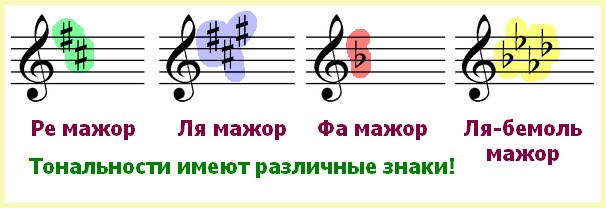
Now let’s ask a question? Are all the keys really, really different and there are no scales that are similar to each other? And is there really a huge unbridgeable gulf between major and minor? It turns out, no, they have connections and similarities, more on that later.
Parallel keys
What do the words “parallel” or “parallelism” mean? Here are such well-known expressions to you as “parallel lines” or “parallel world”. Parallel is one that exists simultaneously with something and is similar to this something. And the word “parallel” is very similar to the word “pair”, that is, two objects, two things, or some other pair are always parallel to each other.
Parallel lines are two lines that are in the same plane, are similar to each other like two drops of water and do not intersect (they are related, but do not intersect – well, isn’t it dramatic?). Remember, in geometry, parallel lines are denoted by two strokes ( // like this), in music, too, such a designation will be acceptable.
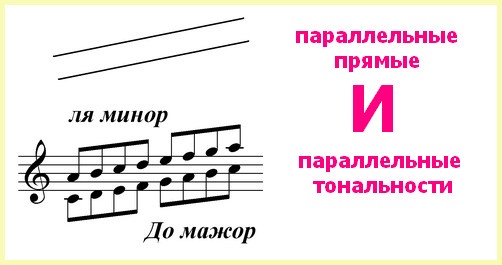
So, here are parallel keys – these are two keys that are similar to each other. There is quite a lot in common between them, but there are also significant differences. What common? They have absolutely all sounds in common. Since the sounds all coincide, it means that all signs must be the same – sharps and flats. So it is: parallel keys have the same signs.
For example, let’s take two keys C MAJOR and A MINOR – both there and there there are no signs, all sounds coincide, which means that these keys are parallel.

Another example. The key of MI-FLAT MAJOR with three flats (si, mi, la) and the key of C MINOR also with the same three flats. Again we see parallel keys.
What then is the difference between these tonalities? And you yourself carefully look at the names (C MAJOR // A MINOR). What do you think? You see, after all, one key is major, and the second is minor. In the example with the second pair (MI-FLAT MAJOR // C MINOR), the same is true: one is major, the other is minor. This means that parallel keys have the opposite modal inclination, the opposite mode. One key will always be major, and the second – minor. That’s right: opposites attract!
What else is different? The C-MAJOR scale starts with the note DO, that is, the note DO in it is the tonic. The A MINOR scale begins, as you understand, with the note LA, which is the tonic in this key. That is, what happens? The sounds in these keys are absolutely the same, but they have different supreme commanders, different tonics. Here is the second difference.
Let’s draw some conclusions. So, parallel keys are two keys that have the same scale sounds, the same signs (sharps or flats), but the tonics differ and the mode is opposite (one is major, the other is minor).

More examples of parallel keys:
- D MAJOR // B MINOR (both there and there are two sharps – F and C);
- A MAJOR // F SHARP MINOR (three sharps in each key);
- F MAJOR // D MINOR (one common flat – B flat);
- B FLAT MAJOR // G MINOR (two flats both there and here – si and mi).
How do I find parallel key?
If you want to know how to determine the parallel key, then let’s find out the answer to this question empirically. And then we will formulate the rule.
Just imagine: C MAJOR and A MINOR are parallel keys. And now tell me: at what level BEFORE MAJOR is the “entrance to the parallel world”? Or, in other words, what degree of C MAJOR is the tonic of the parallel minor?
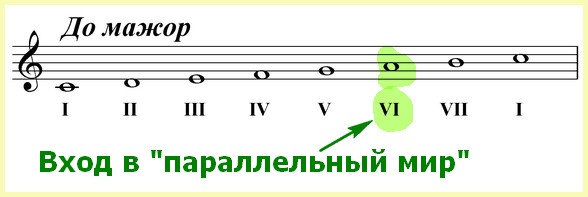
Now let’s do it topsy-turvy. How to get out of the gloomy A MINOR into the parallel sunny and joyful C MAJOR? Where is the “portal” to go to the parallel world this time? In other words, which degree of the minor is the tonic of the parallel major?

The answers are simple. In the first case: the sixth degree is the tonic of the parallel minor. In the second case: the third degree can be considered the tonic of the parallel major. By the way, it is not at all necessary to get to the sixth degree of the major for a long time (that is, to count six steps from the first), it is enough to go down three steps from the tonic and we will get to this sixth degree in the same way.

Let’s formulate now RULE (but not final yet). So, to find the tonic of the parallel minor, it is enough to go down three steps from the first step of the original major key. To find the tonic of the parallel major, on the contrary, you need to go up three steps.
Check this rule with other examples. Do not forget that they have signs. And when we go up or down the steps, we must pronounce these signs, that is, take them into account.
For example, let’s find a parallel minor for the key of G MAJOR. This key contains one sharp (F-sharp), which means that there will also be one sharp in the parallel. We go down three steps from SOL: SOL, F-SHARP, MI. STOP! MI is just the note we need; this is the sixth step and this is the entrance to the parallel minor! This means that the key parallel to G MAJOR will be MI MINOR.

Another example. Let’s find a parallel key for F MINOR. There are four flats in this key (si, mi, la and re-flat). We rise three steps up to open the door to the parallel major. Stepping: F, G, A-FLAT. STOP! A-FLAT – here it is the desired sound, here it is the cherished key! A FLAT MAJOR is the key that is parallel to F MINOR.

How to determine parallel tonality even faster?
How can you find the parallel major or minor even easier? And, especially, if we do not know what signs in general are there in this key? And let’s find out again with examples!
We have just identified the following parallels: G MAJOR // E MINOR and F MINOR // A FLAT MAJOR. And now let’s see what is the distance between the tonics of parallel keys. Distance in music is measured by intervals, and if you are well versed in the topic “Quantitative and Qualitative Value of Intervals”, then you can easily figure out that the interval we are interested in is a minor third.

Between the sounds SOL and MI (down) there is a small third, because we go through three steps, and one and a half tones. Between FA and A-FLAT (up) is also a small third. And between the tonics of other parallel scales, there will also be an interval of a minor third.
It turns out the following RULE (simplified and final): to find a parallel key, you need to set aside a minor third from the tonic – up if we are looking for a parallel major, or down if we are looking for a parallel minor.
Practice (you can skip if everything is clear)
The task: find parallel keys for C SHARP MINOR, B FLAT MINOR, B MAJOR, F SHARP MAJOR.
Decision: you need to build small thirds. So, the small third from C-SHARP upwards is C-SHARP and MI, which means that MI MAJOR will be a parallel key. From B-FLAT it also builds a small third up, because we are looking for a parallel major, we get – D-FLAT MAJOR.
To find the parallel minor, we put the thirds down. So, a minor third from SI gives us G-SHARN MINOR, parallel to SI MAJOR. From F-SHARP, a small third down gives the sound D-SHARP and, accordingly, the system D-SHARP MINOR.

Answers: C-SHARP MINOR // MI MAJOR; B-FLAT MINOR // D-FLAT MAJOR; B MAJOR // G SHARP MINOR; F SHARP MAJOR // D SHARP MINOR.
Are there many pairs of such keys?
In total, three dozen keys are used in music, half of them (15) are major, and the second half (another 15) are minor, and, you know, not a single key is alone, everyone has a pair. That is, it turns out that in total there are 15 pairs of keys that have the same signs. Agree, 15 pairs are easier to remember than 30 individual scales?
Further – even harder! Of the 15 pairs, seven pairs are sharp (from 1 to 7 sharps), seven pairs are flat (from 1 to 7 flats), one pair is like a “white crow” without signs. It seems that you can easily name these two clean tonalities without signs. Isn’t it C MAJOR with A MINOR?
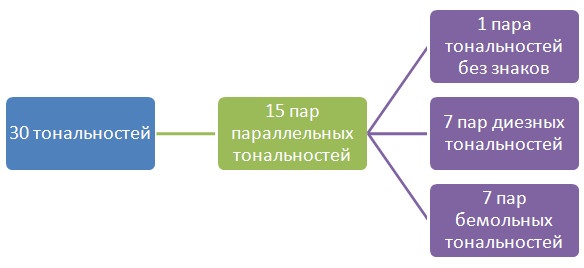
That is, now you need to remember not 30 scary keys with mysterious signs, and not even 15 slightly less frightening pairs, but just the magic code “1 + 7 + 7”. We will now place all these keys in a table for clarity. In this table of keys, it will immediately become clear who is parallel to whom, how many characters and which ones.
Table of parallel keys with their signs
PARALLEL KEYS | THEIR SIGNS | ||
MAJOR | MINOR | HOW MANY SIGNS | WHAT SIGNS |
KEYS WITHOUT SIGNS (1//1) | |||
| C major | La Minor | no signs | no signs |
KEYS WITH SHARP (7//7) | |||
| G major | E minor | 1 sharp | F |
| D major | you are a minor | 2 sharps | fa do |
| A major | F sharp minor | 3 sharps | F to G |
| E major | C-sharp minor | 4 sharps | fa do sol re |
| You are a major | G-sharp minor | 5 sharps | F to G D A |
| F sharp major | D minor | 6 sharps | fa to sol re la mi |
| C sharp major | A-sharp minor | 7 sharps | fa to sol re la we are |
KEYS WITH FLAT (7//7) | |||
| F major | D minor | 1 flat | yours |
| B flat major | G minor | 2 flats | you are mine |
| E-flat major | C minor | 3 flats | you’re gone |
| A flat major | F minor | 4 flats | si mi la re |
| D-flat major | B-flat minor | 5 flat | si mi la re sol |
| G flat major | E-flat minor | 6 flat | sy we la re sol to |
| C flat major | A flat minor | 7 flat | si mi la re sol to fa |
You can download the same table in a more convenient form for use as a cheat sheet in pdf format for printing – DOWNLOAD
That’s all for now. In the next issues, you will learn what the keys of the same name are, as well as how to quickly and permanently remember the signs in the keys, and what is the method for quickly identifying the signs if you have forgotten them.
Well, now we offer you to watch a hand-drawn animated film with amazing music by Mozart. Once Mozart looked out the window and saw that a military regiment was passing along the street. A real military regiment in brilliant uniforms, with flutes and Turkish drums. The beauty and grandeur of this spectacle so shocked Mozart that on the same day he composed his famous “Turkish March” (the finale of the piano sonata No. 11) – a work known throughout the world.
W. A. Mozart “Turkish March”



